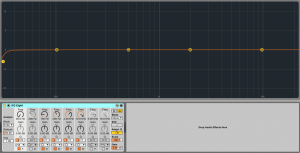Anthony Garvin is an Ableton Certified Trainer at Liveschool, manager of Studios 301 in Alexandria, and techno fanatic, so he knows a thing or two about mixing tracks in Ableton Live. Ahead of his appearance at INPUT and training our next Mixing & Mastering Focus Module, we racked his brain about one of the most important and elusive steps in the mixing process – taming the lower frequency range of your mix with EQ. The question that often arises for producers who are new to EQ is simply knowing where to start. While there are no rules when balancing frequencies, it can be handy to have some guidelines in place, and go-to techniques which will often work across the board.
Before getting to the technicalities, Anthony shared some tips on making the mixing process easier by fixing some common listening and sound selection processes – which can make the mixing process much easier.
“The first thing is that good sounds are far more important than good EQ settings after-the-fact. Ben Feggans, one of my mastering engineer buddies, has a great line – listen to Daft Punk. Their sound is huge, but many of their kicks are deceiving – they sound great but don’t have a huge amount of sub. Their bass lines do. Maybe vice versa sometimes. The lesson is that its the kick or the bass that occupies the sub area – not both!
Monitoring is often a problem too. I can’t encourage people enough to get a sub and headphones. Others will disagree, but if you’re making any kind of music destined for a club, they both really help me hear what’s down there – probably better than your home studios speakers are presenting. Just make sure you invest plenty of time to test, listen, test, listen, test, listen… You get the idea! Put your favourite tracks on and spend plenty of time listening and tuning the sub, and listening on headphones, before you start mixing. This way you’ll acclimatise to your monitoring before mixing anything of your own”
Anthony’s Go-To EQ settings
“When I’m mixing, I try to get away with using EQ in the simplest fashion – just shelves and filters – wherever possible.”
At its fundamental core, good use of EQ is simply balancing frequencies – reducing or removing unwanted frequencies – allowing a each element of your mix to exist in its own frequency range, and leaving the rest of the frequency spectrum for your other elements. For keeping the lower frequency range clear of unwanted and often hardly audible sound, Anthony mentions high pass filters.
“Sometimes, I’ll use a High Pass Filter set at 30Hz, across each element in my mix. This will remove some of the extreme low frequency energy, allowing for that energy to be focused on the other frequencies in the mix.
If I’m having conflicts between the kick and the bass – I’ll use a High Pass Filter on one OR the other – whichever is not the focus of the low end. If it’s House, it’s probably the bass that has the filter. If it’s Drum and Bass, it’s probably the kick that has the filter. It’s often genre dependant, but not always.
You’ll need to be careful with this to find the right frequency – too low and it won’t take out enough low end to make ‘space’, too high and it will end up thin. If you must have a number: 50-75Hz.
Also think about High Pass Filters at 100-200Hz across everything else. Many parts often have low-end that doesn’t need to be there. Generally, your kick and your bass can be the only things below about 100Hz. Experiment with High Pass Filters on and off with all other elements of your mix. You may find that it “opens up” the mix immensely by taking out the garbage.”
EQ is not just for your sounds and instruments; EQing effects is equally important, especially spacial and time based effects.
“It’s good to use High Pass Filters – even up to 300Hz – on your reverb and delay returns. These effects have the potential to really muddy a mix up. This will also aid in re-focussing your low end.”

A more subtle approach can be to use a a HPF in conjunction with a Shelf. The above example would be an alternative to using a HPF at 100Hz.
High Pass filters can often be extreme, and using Shelves can be a more subtle alternative.
“Shelf filtering some low end from the kick and bass is common too. You might want to try a more gentle shelf filter taking out some, but not all, of the end in your kick and/or bass.
Also, a combination of high pass filters and shelves can be a little more gentle and achieve results. For example, using a High Pass Filter at 40Hz, and then a -3dB shelf at 100 Hz. That can be a little less brutal than a High Pass Filter at 100Hz!”
Subscribe to our newsletter to keep up with our latest free tutorials, samples, video interviews and more.
Learn more about Mixing and Mastering.



